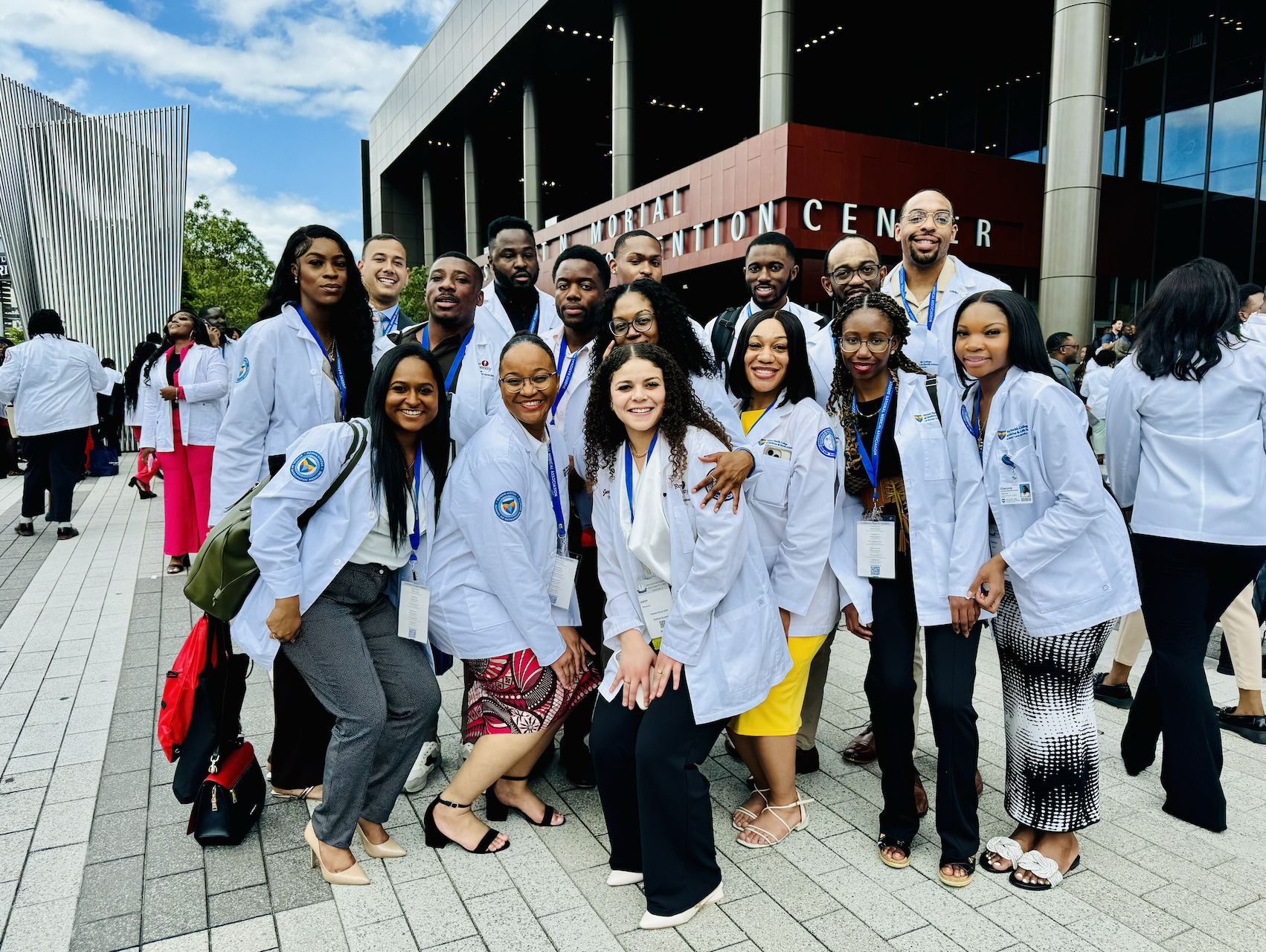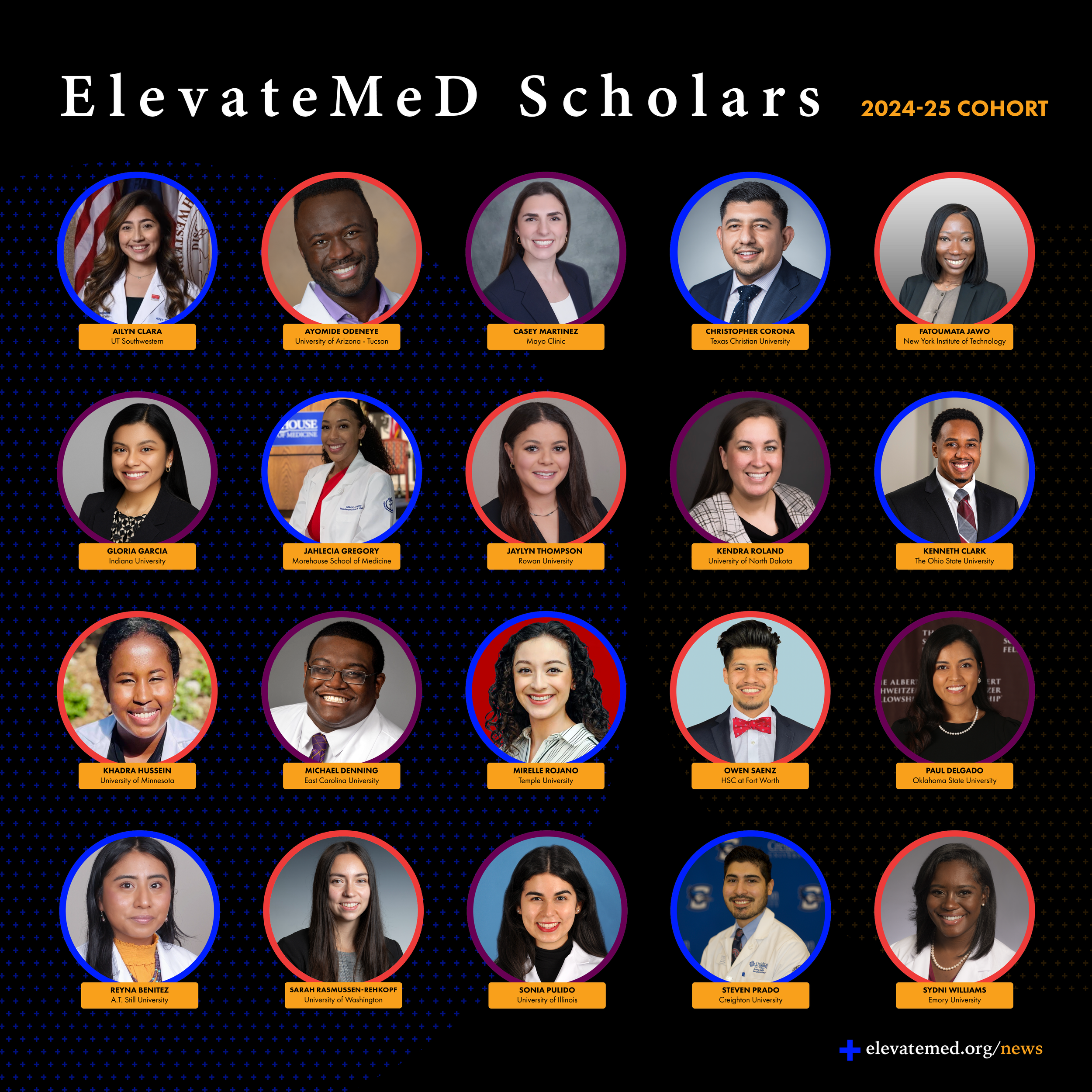
Image Alternative Text: Depicted are diverse Rowan–Virtua School of Osteopathic Medicine (Rowan–Virtua SOM) medical students, with Jaylyn Thompson, OMS–III, at the center of the group, and all student doctors wearing their white coats, at the 2024 Student National Medical Association (SNMA) Annual Medical Education Conference (AMEC). The group is standing outside of the Ernest N. Morial Convention Center in Downtown New Orleans.
Students depicted, back row, left to right: Olatunbosun Olankunri; Danyaal Khan; Albert Owusu–Ansah; Deba Ede–Imafidon; Musa Dolley; Naomi Watkins–Granville; Kylon Coombs; Umar Sannoh; Ajani Morgan; Jordan Clark
Students depicted, front row, left to right: Brittany Eason; Nora Ntsiba; Jaylyn Thompson; Yolanda Williams; Anuj Desai; Cheryce Daniel
This article was developed and written by Patricia Fortunato, with collaboration by Charles A. Barnes II, JD, for the Rowan University Division of Diversity, Equity, and Inclusion (DEI). Please contact Fortunato at fortun83@rowan.edu with comments and/or inquiries in regard to research and contents.
Contents are developed and produced with gratitude to all students and providers at Rowan University who are working to reduce disparities in clinical care and advance health equity, and with gratitude to all communities served.
At the Division of DEI, we believe that birth justice and harm reductionist work is health equity work, and that health equity work is DEI work. As such, through educational content and communications that we develop and/or promote across the Division of DEI blog, website, and social media platforms year-round, we include and strive to advance understanding of the criticality of health equity and prioritizing special populations.
Follow the Rowan University Division of DEI:
- Instagram: instagram.com/rowandei
- Facebook: facebook.com/rowandei
- X/Twitter: twitter.com/rowandei
- Threads: threads.net/@rowandei
Epidemiological Overview of Maternal Health Disparities
There exist significant, persistent racial and ethnic disparities in maternal health care in the United States. Black women/womyn/womxn are up to three times more likely to die a pregnancy-related death, compared to non-Hispanic, non-Latin/a/o/x/e white women/womyn/womxn.1 Per the World Health Organization (WHO), maternal death is defined as "the death of a woman while pregnant or within 42 days of termination of pregnancy, irrespective of the cause of death (obstetric and non-obstetric)."2 Maternal morbidity and mortality is also elevated among Indigenous,3–5 Asian and Native Hawaiian/Pacific Islander (AANHPI),6–10 and Hispanic/Latin/a/o/x/e11,12 women/womyn/womxn.
Across the United States, and on a global scale, there exists an urgent need to reduce racial and ethnic disparities in maternal health outcomes, with increased attention to Black women/womyn/womxn. Racially and ethnically minoritized women/womyn/womxn are overall victimized by high rates of severe maternal morbidity (SMM),8 with Black women/womyn/womxn experiencing the highest rates of SMM.13 Black maternal mortality is a crisis in the U.S. Research acknowledges that systemic racism, discrimination, and socio-economic factors, including reduced access to reproductive health care services, influences these disparities.14,15
These realities have propelled health care professional organizations to prioritize research and policy work focused on reducing racial and ethnic disparities in maternal morbidity and mortality rates across the U.S.16–19 Urgently, a comprehensive approach to clinical quality improvement through the continuum of perinatal and postpartum care is needed, in addition to educating medical students on these disparities; increasing focus on community outreach in medically underserved geographic areas; and driving sustained support in caring for vulnerable special populations, including and especially racially and ethnically minoritized women/womyn/womxn experiencing pregnancy and other factors.
Health Equity Work is DEI Work
At the Division of DEI, we recognize the Black maternal mortality crisis and support all students and colleagues who are working to reduce disparities. Our medical students at the Rowan–Virtua School of Osteopathic Medicine (Rowan–Virtua SOM), part of the Virtua Health College of Medicine and Life Sciences of Rowan University (VHC), are doing paradigm-shifting work in raising awareness and educating the university community on the criticality of Black maternal health disparities, through The Black Collective (TBC) and Medical Students for Birth Justice, led by Jaylyn Thompson, OMS–III and chair of TBC.

Photograph of Jaylyn Thompson, OMS–III, Rowan–Virtua School of Osteopathic Medicine (Rowan–Virtua SOM)
Jaylyn Thompson, OMS–III, DEI Champion
Recently, we had the opportunity to meet with Jaylyn Thompson and learn about her advocacy; medical education goals; and network of supportive fellow medical students, academic clinical faculty, and administration at Rowan–Virtua SOM.
As a former professional soccer player, Thompson didn't predict herself becoming a champion for maternal health equity when she first started medical school. However, she witnessed her sister's high-risk pregnancy and this experience set her on a new path. "I was researching protective factors for maternal health at Duke School of Medicine, when my sister was pregnant with her second child. I basically had the experience of being here, because on her first pregnancy, I was away at college. Just being here and helping her navigate the healthcare system as a Black female on a very, very high-risk pregnancy was extremely eye-opening for me," she explained.
Despite checking all the boxes that should protect a woman during pregnancy—socio-economic status, access to health care, employment, education—she witnessed her sister narrowly avoid a life-threatening "near-miss." This experience solidified Thompson's trajectory, and she felt compelled to advocate for her future patients. "I definitely want to be a reassurance for them," she shared.

Photograph of Jaylyn Thompson, OMS–III, Rowan–Virtua School of Osteopathic Medicine (Rowan–Virtua SOM), right; and Richard Jermyn, DO, FAAPMR, Dean of Rowan–Virtua SOM and Founding Chair of the NeuroMusculoskeletal Institute (NMI), State of New Jersey Medication for Addiction Treatment Center of Excellence (MATCOE), left. Thompson and Jermyn are at SJ Magazine's "2023 Women of Excellence" Awards, where Thompson was honored as the "2023 Woman to Watch."
Thompson's dedication to advocating for and supporting Black women/womyn/womxn experiencing pregnancy was nurtured at Rowan–Virtua SOM, through opportunities with student-run organizations focused on women/womyn/womxn's health equity. "We have so many different student groups that I've been extremely lucky to be a part of," she shared, citing TBC, Student National Medical Association (SNMA), Medical Students for Choice (MSFC), and more. These organizational and leadership experiences, in addition to caring and supportive advisors and deans, allowed her to further focus on maternal health research, while giving back to local communities. "Being in this area provides you with an overload of opportunities to be involved in the community and to work with underserved populations, and that's something that's definitely important to me," she explained.

Image Alternative Text: Depicted is a collage featuring headshots, names, and titles of The Black Collective (TBC), Rowan–Virtua School of Osteopathic Medicine (Rowan–Virtua SOM) chairs. The top row, left to right, depicts Jaylyn Thompson, Chair of Leadership; Naomi Watkins–Granville, Coordinating Chair; and Logistics Chairs, Naya Lopez and Gabrielle Montlouis. The bottom row, left to right, depicts the Chairs of Special Initiatives, Naa Dei Ashie, Quayma Dorch, Lillian Alonzo, and Selah Kamau. The collage is excerpted from the inaugural Rowan–Virtua SOM Black Maternal Health Summit presentation.
Currently, Thompson is preparing for medical residency and recently organized the hugely successful inaugural Black Maternal Health Summit during Black Maternal Health Week 2024. Guest speakers included Chanel Porchia–Albert, CD, CPD, CLC, CHHC, birth justice and reproductive justice advocate and doula committed to Black and Hispanic/Latin/a/o/x/e birthing people; and Planned Parenthood of Northern, Central, and Southern New Jersey (PPNCSJ). Division of DEI leadership was fortunate to attend the summit, where discussion focused on emotional colonization (removing autonomy by judging and/or disempowering racially and ethnically minoritized people, including patients), cultural humility, advocacy tools, and the under-representation of Black bodies in medical education content, among other topics. The full video from the event is available at this link.

Image Alternative Text: Depicted is a collage featuring the ElevateMeD Scholars Program 2024–2025 Cohort, with headshots, names, and medical school affiliations of all scholars. The second row depicts Jaylyn Thompson, OMS–III, Rowan–Virtua School of Osteopathic Medicine (Rowan–Virtua SOM). The collage is via ElevateMeD.
Most recently, Thompson was selected for the ElevateMeD Scholars Program 2024–2025 Cohort, joining 19 fellow scholars from medical schools across the U.S. Each recipient has been awarded a $10,000 tuition-based scholarship. The program supports underrepresented medical students and strives to increase diversity and cultural responsiveness in medicine, providing mentorship, leadership development, financial management training, and peer support.
Looking ahead, at Rowan–Virtua SOM, Thompson is hopeful to see more racial and ethnic diversity among academic clinical faculty, and curricula that reflect the reality of caring for patients of color. As she emphasized, "It makes a huge difference. I think in fields like dermatology, those pathologies present extremely differently for minority patients versus Caucasian patients."
Thompson shared with us that she feels well-prepared to provide compassionate, culturally responsive care for minoritized and marginalized special populations. Through persistence, mentorship, and listening to and centering these populations, she is actively eradicating racial and ethnic disparities in maternal health and advancing health equity. We recognize Jaylyn Thompson as a DEI Champion, and look forward to continuing to promote, support, and help advance the critical, lifesaving work of The Black Collective and Medical Students for Birth Justice.
If you would like to collaborate with The Black Collective and Medical Students for Birth Justice, please email Thompson directly at thomps94@rowan.edu.
Resources for Continued Learning
- Nurture NJ, a State of New Jersey initiative "committed to transforming New Jersey into the safest and most equitable state in the nation to deliver and raise a baby"
- Maternal Data Initiative from the New Jersey Department of Health (NJ DOH), containing epidemiological state-based data, state services and resources, and recommended literature
- Planned Parenthood of Northern, Central, and Southern New Jersey (PPNCSJ), providing sexual and reproductive health care, education, and advocacy
- My Black Health is Beautiful curricula covering reproductive and Black maternal health
- Empowering Mothers to Parent and Overcome with Resilience (EMPOWR) health communication series (collated handouts) on perinatal and postpartum harm reduction and mental health*
*Further recognizing the urgent need for a comprehensive approach through the continuum of perinatal and postpartum care for vulnerable special populations experiencing pregnancy, parenting, and complex factors, including substance use, we share the following research and resources:
Aligned with the continuum of health equity, we recognize that perinatal and postpartum substance dependence or substance use disorder (SUD) is a crisis in the U.S.20–23 Overdose is a leading cause of death during the perinatal and postpartum stages.24,20 Women/womyn/womxn who are experiencing substance dependence are at highest risk for SUD during reproductive health care years.25 Substance use during pregnancy remains a critical issue in the U.S., with high rates of polysubstance use,26 all associated with adverse outcomes. Further, racially and ethnically minoritized people experiencing substance use, substance dependence, or SUD have historically experienced disproportionate criminalization, and still, correlated with punitive drug policies that continue to severely harm families and communities of color.27–29
All forms of stigma30—cultural and/or familial stigma, public perception, employment discrimination, health care professional stigma—prevent and hinder racially and ethnically minoritized people and with intersecting identities from receiving and retaining evidence-based care. Perinatal and postpartum harm reduction is rooted in a reproductive justice framework, supporting people who are experiencing substance use during pregnancy in seeking help without punitive measures. Our academic clinical faculty colleagues facilitate State of New Jersey-designated Centers of Excellence for SUD, providing evidence-based medical and behavioral health care through a harm reductionist lens. Learn more about the NeuroMusculoskeletal Institute (NMI) at Rowan–Virtua SOM at this link; and the Center for Healing, run by Cooper Medical School of Rowan University (CMSRU)-affiliated academic clinical faculty, at this link.
References
- Centers for Disease Control and Prevention (CDC), Office of Health Equity (OHE). (2024). Working Together to Reduce Black Maternal Mortality. CDC. Retrieved from cdc.gov/healthequity/features/maternal-mortality/index.html on May 19, 2024.
- World Health Organization (WHO), Sexual and Reproductive Health and Research (SRH). (2023). Trends in Maternal Mortality 2000 to 2020: Estimates by WHO, UNICEF, UNFPA, World Bank Group, and UNDESA/Population Division. WHO. Retrieved from who.int/publications/i/item/9789240068759 on May 19, 2024.
- Centers for Disease Control and Prevention (CDC), Hear Her Campaign. (2024). Disparities and Resilience Among American Indian and Alaska Native People who are Pregnant or Postpartum. CDC. Retrieved from cdc.gov/hearher/aian/disparities.html on May 19, 2024.
- Kozhimannil, K. B. (2020). Indigenous Maternal Health—A Crisis Demanding Attention. In JAMA Health Forum (Vol. 1, No. 5, pp. e200517–e200517). American Medical Association (AMA).
- Kozhimannil, K. B., Interrante, J. D., Tofte, A. N., & Admon, L. K. (2020). Severe Maternal Morbidity and Mortality Among Indigenous Women in the United States. Obstetrics & Gynecology, 135(2), 294–300.
- Grob, P. C., Tindal, R. R., Lundeberg, K. R., Hamilton, J. L., Gonzalez–Brown, V. M., & Keyser, E. A. (2023). Increased Maternal Morbidity and Mortality Among Asian American and Pacific Islander Women in the Military Health System. AJOG Global Reports, 3(2), 100212.
- Parchem, J. G., Gupta, M., Chen, H. Y., Wagner, S., Mendez–Figueroa, H., & Chauhan, S. P. (2020). Adverse Infant and Maternal Outcomes Among Low-Risk Term Pregnancies Stratified by Race and Ethnicity. Obstetrics & Gynecology, 135(4), 925–934.
- Hill, L., Artiga, S., & Ranji, U. (2022). Racial Disparities in Maternal and Infant Health: Current Status and Efforts to Address Them. Kaiser Family Foundation (KFF), 1.
- Gordon, N. P., Lin, T. Y., Rau, J., & Lo, J. C. (2019). Aggregation of Asian–American Subgroups Masks Meaningful Differences in Health and Health Risks Among Asian Ethnicities: An Electronic Health Record Based Cohort Study. BMC Public Health, 19, 1–14.
- Wagner, S. M., Bicocca, M. J., Gupta, M., Chauhan, S. P., Mendez–Figueroa, H., & Parchem, J. G. (2020). Disparities in Adverse Maternal Outcomes Among Asian Women in the US Delivering at Term. JAMA Network Open, 3(10), e2020180–e2020180.
- Baumgartel, K., Saint Fleur, A., Prescott, S., Fanfan, D., Elliott, A., Yoo, J. Y., ... & Groer, M. W. (2023). Social Determinants of Health Among Pregnant Hispanic Women and Associated Psychological Outcomes. Journal of Racial and Ethnic Health Disparities, 1–10.
- Hoyert, D. L. (2022). Maternal Mortality Rates in the United States, 2020. Centers for Disease Control and Prevention (CDC), National Center for Health Statistics (NCHS) Health E–Stats. Retrieved from cdc.gov/nchs/data/hestat/maternal-mortality/2020/maternal-mortality-rates-2020.htm on May 19, 2024.
- Liese, K. L., Mogos, M., Abboud, S., Decocker, K., Koch, A. R., & Geller, S. E. (2019). Racial and Ethnic Disparities in Severe Maternal Morbidity in the United States. Journal of Racial and Ethnic Health Disparities, 6, 790–798.
- Njoku, A., Evans, M., Nimo–Sefah, L., & Bailey, J. (2023). Listen to the Whispers Before They Become Screams: Addressing Black Maternal Morbidity and Mortality in the United States. In Healthcare (Vol. 11, No. 3, p. 438). MDPI.
- Bose, T. (2023). Racism in Health: The Roots of the US Black Maternal Mortality Crisis. Nature.
- American Medical Association (AMA). (2024). AMA Advocacy to Improve Maternal Health. AMA. Retrieved from ama-assn.org/delivering-care/public-health/ama-advocacy-improve-maternal-health on May 19, 2024.
- American Medical Association (AMA). (2024). AMA Recommendations to Improve Maternal Health Outcomes. AMA. Retrieved from ama-assn.org/delivering-care/public-health/ama-recommendations-improve-maternal-health-outcomes on May 19, 2024.
- American Medical Association (AMA). (2024). AMA Initiatives to Improve Maternal Health Outcomes. AMA. Retrieved from ama-assn.org/delivering-care/public-health/ama-initiatives-improve-maternal-health-outcomes on May 19, 2024.
- American College of Obstetricians and Gynecologists (ACOG). (2024). Eliminating Preventable Maternal Mortality and Morbidity. ACOG. Retrieved from acog.org/advocacy/policy-priorities/maternal-mortality-prevention on May 19, 2024.
- Trost, S. L., Busacker, A., Leonard, M., et al. (2024). Pregnancy-Related Deaths: Data from Maternal Mortality Review Committees in 38 U.S. States, 2020. Centers for Disease Control and Prevention (CDC), Maternal Mortality Prevention. Retrieved from cdc.gov/maternal-mortality/php/data-research on May 19, 2024.
- Lien, J., Hayes, T., Liu–Smith, F., & Rana, D. (2023). Comparing Maternal Substance Use and Perinatal Outcomes Before and During the COVID–19 Pandemic. Journal of Perinatology, 43(5), 664–669.
- Spencer, M. R., Miniño, A. M., & Warner, M. (2022). Drug Overdose Deaths in the United States, 2001–2021. Retrieved from cdc.gov/nchs/products/databriefs/db457.htm on May 19, 2024.
- United States Government Accountability Office (GAO). (2022). Report to Congressional Addresses: Maternal Health: Outcomes Worsened and Disparities Persisted During the Pandemic. GAO. Retrieved from gao.gov/products/gao-23-105871 on May 19, 2024.
- Bruzelius, E., & Martins, S. S. (2022). US Trends in Drug Overdose Mortality Among Pregnant and Postpartum Persons, 2017–2020. JAMA, 328(21), 2159–2161.
- Woolf, S. H., & Schoomaker, H. (2019). Life Expectancy and Mortality Rates in the United States, 1959–2017. JAMA, 322(20), 1996–2016.
- Tran, E. L., England, L. J., Park, Y., Denny, C. H., & Kim, S. Y. (2023). Systematic Review: Polysubstance Prevalence Estimates Reported During Pregnancy, US, 2009–2020. Maternal and Child Health Journal, 27(3), 426–458.
- Cohen, A., Vakharia, S. P., Netherland, J., & Frederique, K. (2022). How the War on Drugs Impacts Social Determinants of Health Beyond the Criminal Legal System. Annals of Medicine, 54(1), 2024–2038.
- Fornili, K. S. (2018). Racialized Mass Incarceration and the War on Drugs: A Critical Race Theory Appraisal. Journal of Addictions Nursing, 29(1), 65–72.
- Newkirk, V. R. (2017). What the "Crack Baby" Panic Reveals about the Opioid Epidemic. The Atlantic.
- Fortunato, P., Jones, I., & Baston, K. E. (2022; contents updated as of Spring 2023). Substance Use Disorder Language Guide for Clinical and Educational Teams. Southern New Jersey Medication for Addiction Treatment Center of Excellence (MATCOE).